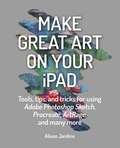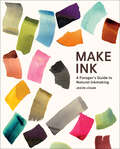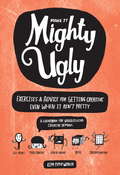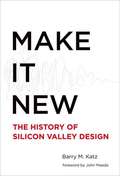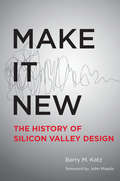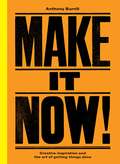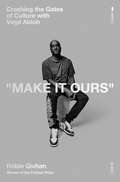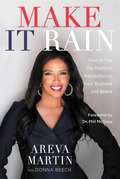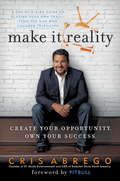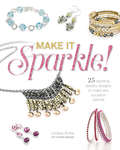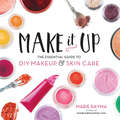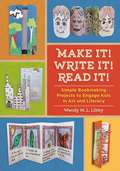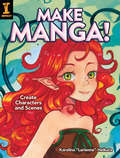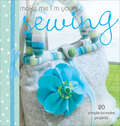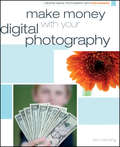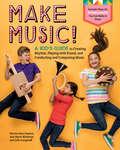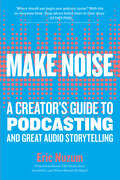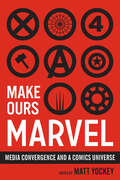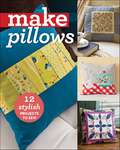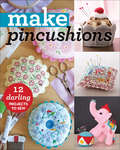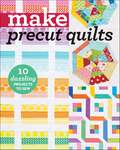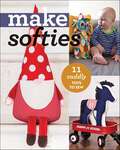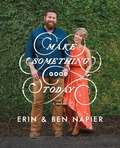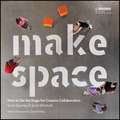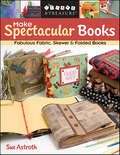- Table View
- List View
Make Great Art on Your iPad: Draw, Paint & Share
by Alison JardineFully revised to reflect the latest updates in the most popular creativity apps, this is the original, best-selling guide to using creative apps on your Apple device to produce your very own masterpieces. Artists like David Hockney have taken to creating art on the iPad, but you don't have to be an artist to achieve great results on your device. This refreshingly accessible book is perfect for skilled artists and creative wannabes alike. Alongside the step-by-step projects that teach the fundamentals of digital painting, there are also some easy and fun artistic tricks that anyone can try. You'll master the most popular art apps, and you will learn new painting and drawing skills along the way.Includes advice on using Procreate, ArtRage, Art Studio for iPad, Adobe Photoshop Sketch, Pen & Ink, Brushes and Tayasui Sketches Pro.
Make Ink: A Forager's Guide to Natural Inkmaking
by Jason Logan“The pigments he concocts from these humble beginnings are as fun to make as they are eye-opening to work with . . . the world never quite looks the same.” —MarthaStewart.comA 2018 Best Book of the Year—The GuardianThe Toronto Ink Company was founded in 2014 by designer and artist Jason Logan as a citizen science experiment to make eco-friendly, urban ink from street-harvested pigments. In Make Ink, Logan delves into the history of inkmaking and the science of distilling pigment from the natural world. Readers will learn how to forage for materials such as soot, rust, cigarette butts, peach pits, and black walnut, then how to mix, test, and transform these ingredients into rich, vibrant inks that are sensitive to both place and environment. Organized by color, and featuring lovely minimalist photography throughout, Make Ink combines science, art, and craft to instill the basics of ink making and demonstrate the beauty and necessity of engaging with one of mankind’s oldest tools of communication.“Logan demystifies the process, encouraging experimentation and taking a fresh look at urban environments.” —NPR“The book is full of inspiration and takes a lot of the mystery out of ink making, at least at its simplest level. And it also reminds me why I love ink—any ink or liquid color as much as I do.” —The Well-Appointed Desk“Quite a few recipes . . . that use color from the kitchen: carrots, black beans, blueberries, turmeric, and onion skins all make beautiful ink colors.” —Design Observer“Make Ink opens up about methods, providing an open source guide to DIY ink.” —CityLab
Make It Mighty Ugly
by Kim Piper Werker Kate Bingaman-BurtFans of DIY projects and crafts will conquer their fear of failure and create their own masterpieces using this fun and inspiring handbook. Get Crafty. Make Great Stuff. Be Creative! The number one fear of all creative types--crafters, DIYers, makers, artists--is that failure lurks right around the corner. Crafty blogger and creativity guru Kim Piper Werker urges everyone to pick up their pen or paintbrush or scissors and make something mighty ugly: get that "failure" out of the way. This friendly book offers up a multi-pronged approach to overcoming creative fears through inspiring essays and anecdotes, interviews, exercises and prompts, and sage advice from all over the creative spectrum to help individuals slay their creative demons.From the Trade Paperback edition.
Make It New
by Barry M. KatzCalifornia's Silicon Valley is home to the greatest concentration of designers in the world: corporate design offices at flagship technology companies and volunteers at nonprofit NGOs; global design consultancies and boutique studios; research laboratories and academic design programs. Together they form the interconnected network that is Silicon Valley. Apple products are famously "Designed in California," but, as Barry Katz shows in this first-ever, extensively illustrated history, the role of design in Silicon Valley began decades before Steve Jobs and Steve Wozniak dreamed up Apple in a garage. Offering a thoroughly original view of the subject, Katz tells how design helped transform Silicon Valley into the most powerful engine of innovation in the world. From Hewlett-Packard and Ampex in the 1950s to Google and Facebook today, design has provided the bridge between research and development, art and engineering, technical performance and human behavior. Katz traces the origins of all of the leading consultancies -- including IDEO, frog, and Lunar -- and shows the process by which some of the world's most influential companies came to place design at the center of their business strategies. At the same time, universities, foundations, and even governments have learned to apply "design thinking" to their missions. Drawing on unprecedented access to a vast array of primary sources and interviews with nearly every influential design leader -- including Douglas Engelbart, Steve Jobs, and Don Norman -- Katz reveals design to be the missing link in Silicon Valley's ecosystem of innovation.
Make It New: A History of Silicon Valley Design (The\mit Press Ser.)
by Barry M. KatzThe role of design in the formation of the Silicon Valley ecosystem of innovation.California's Silicon Valley is home to the greatest concentration of designers in the world: corporate design offices at flagship technology companies and volunteers at nonprofit NGOs; global design consultancies and boutique studios; research laboratories and academic design programs. Together they form the interconnected network that is Silicon Valley. Apple products are famously “Designed in California,” but, as Barry Katz shows in this first-ever, extensively illustrated history, the role of design in Silicon Valley began decades before Steve Jobs and Steve Wozniak dreamed up Apple in a garage.Offering a thoroughly original view of the subject, Katz tells how design helped transform Silicon Valley into the most powerful engine of innovation in the world. From Hewlett-Packard and Ampex in the 1950s to Google and Facebook today, design has provided the bridge between research and development, art and engineering, technical performance and human behavior. Katz traces the origins of all of the leading consultancies—including IDEO, frog, and Lunar—and shows the process by which some of the world's most influential companies came to place design at the center of their business strategies. At the same time, universities, foundations, and even governments have learned to apply “design thinking” to their missions. Drawing on unprecedented access to a vast array of primary sources and interviews with nearly every influential design leader—including Douglas Engelbart, Steve Jobs, and Don Norman—Katz reveals design to be the missing link in Silicon Valley's ecosystem of innovation.
Make It Now!: Creative Inspiration and the Art of Getting Things Done
by Anthony Burrill'If you’re stuck for an idea, have a big decision to handle or need a new perspective on a problem, here are some approaches for thinking, communicating and creativity. An upbeat guide that anyone can use to help with the big and small challenges we face every day.’ Anthony BurrillA life-affirming guide to new thinking, creative problem-solving and getting things done from graphic artist Anthony Burrill. Full of inspiration and ideas, his best-loved prints as well as new work, this book will get you thinking bigger and better and recharge your creativity.
Make It Ours: Crashing the Gates of Culture with Virgil Abloh
by Robin GivhanHow Virgil Abloh&’s iconic rise to the top of the fashion industry embodied a groundbreaking transformation of the relationship between who we are and what we wear.&“Thoughtful, intelligent, honest, and masterfully crafted . . . Virgil&’s freethinking and influence on the possibilities of what creativity can be was a tour de force.&”—Marc JacobsVirgil Abloh&’s appointment as head of menswear for Louis Vuitton in 2018 shocked the fashion industry, as he became the first Black designer to serve as artistic director in the brand&’s 164-year history. But as Pulitzer Prize–winning culture critic Robin Givhan reveals, Abloh&’s story encompasses so much more than his own journey.Using Abloh&’s surprising path to the top of the luxury establishment, Givhan unfolds the larger story of how the cloistered, exclusive fashion world faced a revolution from below in the form of streetwear and designers unafraid to storm the gates—how their notions of what was luxury simultaneously anticipated and upended consumer preferences, and how a simple T-shirt held as much cultural power as a haute couture gown. As Givhan relays, Abloh rose during a time of existential angst for a fashion industry trying to make sense of its responsibilities to a diverse audience and the challenges of selling status to a generation of consumers who fetishized sneakers and prioritized comfort. The story of how that moment came to be, and how someone like Abloh—who had no formal training in pattern-making or tailoring—could come to symbolize and embody the industry&’s way forward, is the story at the heart of this book.Make It Ours is at once a remarkable biography of a singular creative force and a powerful meditation on fashion and race, taste and exclusivity, genius and luxury. With access to Abloh&’s family, friends, collaborators, and contemporaries, and featuring a cast of fascinating characters ranging from visionary Black designers like Ozwald Boateng to Abloh&’s mercurial but critical employer and mentor Kanye West, Givhan weaves a spellbinding tale of a young man&’s rise amid a cultural moment that would upend a century&’s worth of ideas about luxury and taste.
Make It Rain!: How To Use The Media To Revolutionize Your Business & Brand
by Areva Martin Donna Beech Phil McGrawWhat if you could get in front of millions of prospects with the avid endorsement of famous influencers--without spending a dime?It's happening right in front of you every day. Guest experts on TV, radio, podcasts, blogs, and live streaming are getting local and national exposure for their business and brand that they could never have afforded to reach with ads.For a decade, Areva Martin has used the media to build a huge platform that expanded the influence and power of her brand exponentially. Media appearances on Dr. Phil, Anderson Cooper 360, The Doctors, CNN, MSNBC, FOX, and more have virtually eliminated the need of a marketing budget for her thriving law firm and non-profit organization, while securing her place as one of America's most sought after thought leaders.In Make It Rain! Areva breaks the silence to reveal what insiders know about the power of media appearances to revolutionize a business and brand and get your core message out to the people who need it most. You'll learn how to: Match your brand to the right audience and media venues Craft pitches producers can't resist Jump on breaking news shows Pivot and speak in soundbites like the pros Amplify every interview with social media Turn appearances into platform and become a rainmakerNever before have there been more ways to build a presence that matters. Whether you are the executive of a corporation, the author of an upcoming book, the owner of a rapidly growing small business, or the public face of a local nonprofit or association, if you have a business to build or people you want to help, nothing beats using the media to create the visibility, influence, and power you need. Are you ready to Make It Rain!?
Make It Reality: Create Your Opportunity, Own Your Success
by Cris Abrego PitbullThe creator and producer of several mega-hit television series, including The Surreal Life, Flavor of Love, Rock of Love, and Charm School, shares his incredible journey of making it to the top--and how you can too. "No one paves the road for you. You have to create your own path. If you believe in your dreams, embrace what makes you different, and bet on yourself, the destination will be greater than you ever imagined."--Cris Abrego From carrying camera gear on the sets of MTV's Road Rules, to pioneering the celebreality genre by creating such breakout hits as The Surreal Life and The Flavor of Love, and now as one of today's most prominent figures in the television industry--Cris Abrego's career has been nothing short of extraordinary. As a young boy growing up in L.A., Abrego spent his formative years glued to his family's TV set, forging his dream of one day working in television. With unrelenting drive, he overcame countless obstacles to build his own reality TV production company in his garage, which, by his mid-thirties, he sold to one of the world's largest television production companies, before being tapped as their co-CEO. In Make It Reality, Abrego provides practical and motivating lessons collected from almost twenty years on the frontlines of television, including: how to visualize and your goals and work tirelessly to attain them; when to take risks and push boundaries; and how to continually raise the bar for yourself and realize there are no limits on what can be achieved. Success isn't about your pedigree or your connections: it's about vision, leadership, and courage. Abrego's story is unforgettable, full of heart, and inspiring to anyone seeking to transcend all obstacles and achieve true success.Foreword by PitbullFrom the Hardcover edition.
Make It Sparkle: 25 Dazzling Jewelry Designs to Make Any Occasion Special
by Lindsay BurkeA little shine--a lot of fun! Stand out from the crowd with the cute and carefree jewelry in Make it Sparkle! Inside, jewelry junkie Lindsay Burke of Fusion Beads shares 25 colorful, sparkling pieces that will make any outfit pop. Pair crystals and bangles for Pink Party Bracelets, perfect for stacking. Turn a gray day around with pendants and French hoops with Rain City Earrings. Dress up your favorite jeans when you pair them with your very own Denim Ice Necklace, a multi-strand must-have your friends will be dying to borrow. Featuring easy-to-follow instructions and step-by-step photos, any project can be personalized by adding your own choices for colors, shapes, and metals. Even if you've never made your own jewelry, soon you'll be ready to Make it Sparkle!
Make It Up: The Essential Guide to DIY Makeup and Skin Care
by Marie RaymaEver think of making your own beauty products- handmade, high performance, healthy alternatives to just about every chemical laden product you currently put on your face and body? It's easier than you think!In Make It Up author Marie Rayma shares the recipes she has developed through years of trial, error, and testing to come up with the very best. This is real makeup and skincare: bright lipsticks, quality mineral powders, long-wearing eyeliners, and masks and cleansers that yield results. Rayma walks you through natural ingredients available online or at health food stores. These awesome oils, butters, clays, and minerals will replace the petroleum products, artificial colors, and lab-created mystery fragrances that have untold effects on our bodies. Products can be tailored for individual needs-from swapping out ingredients not suitable for sensitive skin to whipping up the perfect colors suited for any complexion.With easy-to-follow instruction, Make It Up provides more than 40 essential cosmetics and skin care projects so you can make just what you want, when you need it.
Make It! Write It! Read It!: Simple Bookmaking Projects to Engage Kids in Art and Literacy
by Wendy LibbyCrafting projects that provide literacy and curriculum ideas to enrich the classroom Make It! Write It! Read It! develops art and literacy skills through the craft of bookmaking, inspiring elementary-aged children to read, write, and tell stories with their creations. Creative, fun, field-tested projects include 17 different blank book designs such as accordion fold, coffee filter, hanging tassel, and paper bag books. These designs are then applied to 23 specific book projects kids are sure to love, with suggestions for making literary connections--writing poems, paragraphs, or simple stories related to their creations. Kids will delight in making books that include three-part fish, a creature pop-up, a double-sided mountain, and an ocean scene, among many others. Carefully crafted with teachers and parents or caregivers of kids aged 4-10 in mind, each activity has educational objectives for the project; skills developed; materials needed; clear, illustrated, step-by-step instructions; and literary connection ideas. The text is specific enough for beginners who need more direction yet offers open-ended possibilities for imagination and creation for more experienced bookmakers, writers, and artists.
Make Manga!: Create Characters and Scenes
by Karolina Larienne" HeikuraHow to Make Your Own Exciting Manga Story! An artist's greatest gift is his or her imagination. By learning how to create manga characters with personality--and place them in engaging backgrounds--you can tell any story you want to! First, learn the basics of sketching: how to draw faces, figures, expressions and clothing. Then, practice inspirational prompts on coloring, composition and creativity to inspire endless story ideas. Use symbolism, mood and accessories to draw fantastic or realistic scenes. Use both traditional and digital coloring techniques to find your own engaging manga style. More than 30 step-by-step tutorials teach you:The basics of human anatomy and manga-specific proportionsThe fundamentals of coloring skin tones, clothing and backgrounds with markers, watercolor and digital enhancementsCompelling character ideas, like Gijinkas--cute personifications of food, nature and objectsHow to incorporate all of those various elements to build a cool and complete scene"Bring your own visions to life!" ~Karolina "Larienne" Heikura
Make Me I'm Yours ... Sewing: 20 simple-to-make projects
by VariousLearn how to sew with this stylish collection of twenty irresistible hand and sewing machine projects, including bags, gifts, and pillows.Discover the pleasure of making your own chic and unique designs with these simple-to-make patterns. Transform yourself from a needlecraft novice to an embellishment expert with this sewing savvy guide. Choose from pretty and stylish gift ideas for you and your friends and go fabric shopping today.This book is packed with ideas, needlecraft techniques, step-by-step instructions, and handy tips to make it fun and easy. It has ideas for you and your home, from beautiful bags to vibrant cushions. Everyone will find a project they adore.
Make Money with your Digital Photography
by Erin ManningLearn to find the opportunities and make money with your digital cameraMost digital photo buffs have thought about turning their hobby into a side business, but building a successful business takes more than passion and photographic skill. Erin Manning knows how, and she shares her expertise in this nuts-and-bolts guide.Manning, host of the DIY Network's The Whole Picture, shows you how to identify and act on opportunities, make a business plan, and manage your business from day to day. Make Money with Your Digital Photography is also full of tips to help you improve your product.Shows how to find opportunities to get paid for your photography and how to follow up on themHelps photographers identify and prepare for pitfalls and problems they may confrontPacked with advice from the author's own experience in starting and building her own photography businessExplores popular genres, including wedding photography, shooting children's sports, and taking family portraitsIncludes tips and tricks for improving your photosWritten by a successful photographer and host of DIY Network's The Whole PictureIf you've considered turning your digital photography hobby into a money-making venture, Make Money with Your Digital Photography shows you how to get there.
Make Music!: A Kid's Guide to Creating Rhythm, Playing with Sound, and Conducting and Composing Music (Music Makes A Difference Ser.)
by John Langstaff Ann Sayre Wiseman Norma Jean HaynesMusic is for everyone — no prior experience required! Make Music! invites kids and families to celebrate the joy of sound with a variety of inventive activities, including playing dandelion trumpets, conducting percussion conversations, and composing their own pieces. Musician and educator Norma Jean Haynes brings the pioneering work of Ann Sayre Wiseman and John Langstaff to a new generation of kids aged 5 and up, focusing on the playfulness, spontaneity, and creativity of music. Kids explore rhythm with clapping, body drumming, and intonations. They learn to create found sound with kitchen pots and pans, the Sunday paper, or even the Velcro on their sneakers. And step-by-step instructions show how to make 35 different instruments, from chimes and bucket drums to a comb kazoo and a milk carton guitar. This publication conforms to the EPUB Accessibility specification at WCAG 2.0 Level AA.
Make Noise: A Creator's Guide to Podcasting and Great Audio Storytelling
by Eric Nuzum&“An interestingly idiosyncratic and personal vision of how to make podcasts.&”—Ira Glass Veteran podcast creator and strategist Eric Nuzum distills a career&’s worth of wisdom, advice, practical information, and big-picture thinking to help podcasters &“make noise&”—to stand out in this fastest of fastest-growing media universes. Nuzum identifies core principles, including what he considers the key to successful audio storytelling: learning to think the way your audience listens. He delivers essential how-tos, from conducting an effective interview to marketing your podcast, developing your audience, and managing a creative team. He also taps into his deep network to offer advice from audio stars like Ira Glass, Terry Gross, and Anna Sale. The book&’s insights and guidance will help readers successfully express themselves as effective audio storytellers, whether for business or pleasure, or a mixture of both.
Make Ours Marvel: Media Convergence and a Comics Universe (World Comics And Graphic Nonfiction Ser.)
by Matt YockeyThe creation of the Fantastic Four effectively launched the Marvel Comics brand in 1961. Within ten years, the introduction (or reintroduction) of characters such as Spider-Man, the Hulk, Iron Man, Captain America, and the X-Men catapulted Marvel past its primary rival, DC Comics, for domination of the comic book market. Since the 2000s, the company&’s iconic characters have leaped from page to screens with the creation of the Marvel Cinematic Universe, which includes everything from live-action film franchises of Iron Man and the Avengers to television and streaming media, including the critically acclaimed Netflix series Daredevil and Jessica Jones. Marvel, now owned by Disney, has clearly found the key to transmedia success. Make Ours Marvel traces the rise of the Marvel brand and its transformation into a transmedia empire over the past fifty years. A dozen original essays range across topics such as how Marvel expanded the notion of an all-star team book with The Avengers, which provided a roadmap for the later films, to the company&’s attempts to create lasting female characters and readerships, to its regular endeavors to reinvigorate its brand while still maintaining the stability that fans crave. Demonstrating that the secret to Marvel&’s success comes from adeptly crossing media boundaries while inviting its audience to participate in creating Marvel&’s narrative universe, this book shows why the company and its characters will continue to influence storytelling and transmedia empire building for the foreseeable future.
Make Pillows: 12 Stylish Projects to Sew
by C&T PublishingDecorative pillows in a day! Spruce up your space with 12 pillow patterns you can make in a day! Whatever your style—bold, modern, whimsical, or traditional—you’ll find pretty pillows in a variety of techniques, like patchwork, appliqué, and embroidery. With quick, satisfying projects from top designers, this booklet is a great value for the sewist who loves to start and finish a project in less than a day. Dig into your fabric stash and sew a set of pillows just for you, or give them as gifts! • Something for every style! Traditional, bold, whimsical, and modern patterns for a happy home • Fantastic for gifts, swaps, and busting your stash • Techniques range from piecing to appliqué and embroidery, with motifs included
Make Pincushions: 12 Darling Projects to Sew
by Virginia Lindsay Susan Maw Sally Bell Aneela Hoey Julie M. Creus Jessica Peck Kajsa Wikman Alexia Marcelle Abegg Bari J. Ackerman Jeni Baker Leanne Beasley Jill Hamor Anne SuttonUpgrade your pincushion collection or make the perfect gift for a fellow sewist with these adorable projects from today’s top designers.Tired of the basic tomato pincushion? Why not a little cabin, ladybug, or New York taxi? Make Pincushions features 12 fun and creative projects from designers like Anne Sutton of Bunny Hill Designs, Leanne Beasley of Leanne’s House, and others. You’ll find playful patterns for Pieced Pincushions, 3-D Pincushions, and Embroidered Pincushions. Perfect for swaps, gifts, and stocking stuffers, these charming pincushions are so quick to sew, you’ll want to make them again and again.
Make Precut Quilts: 10 Dazzling Projects to Sew
by C&T PublishingPrecut projects from favorite designers Quilting with precuts is easy, fast, and fun! Feature your favorite fabric collection in these 10 precut-friendly designs using charm packs, layers cakes, and jelly roll strips. The versatile patterns from top designers work with a variety of prints and solids, and beginner and intermediate quilters will love the bright and friendly designs. This value-packed booklet features 5 layer-cake patterns and 5 for charm squares and precut strips—perfect for anyone who wants to jump straight into sewing! • Includes patterns from popular designers Alex Anderson and Liz Aneloski, Cheryl Arkison, Mary Cowan, Rachel Griffith, Sherri McConnell, Amanda Murphy, Allison Nicoll, Camille Roskelley, and Sweetwater • Use the latest precuts from your favorite quilt shop or shop your stash! • Modern and traditional designs in a variety of sizes
Make Softies: 10 Cuddly Toys to Sew
by C&T PublishingGo beyond teddy bears! 11 adorable soft toys to make If you want to sew up a quick gift, make a toy for a baby or toddler, or decorate your home with a little whimsy, look no further than this collection of 11 softies from popular designers Amy Adams, Kirstyn Cogan, Samantha Cotterill, Abby Glassenberg, Jill Hamor, Brenna Maloney, Sweetwater, Kasja Wikman, Annabel Wrigley, and Angela Yosten. Cute houses, cuddly creatures, friendly characters, and even a checkerboard are all achievable with three-dimensional sewing for beginners and experienced sewists. Plus, the projects in this value-packed book will use up your scraps, stash, and even your socks! • Jump into sewing softies with patterns from some of your favorite designers: Amy Adams, Kirstyn Cogan, Samantha Cotterill, Abby Glassenberg, Jill Hamor, Brenna Maloney, Sweetwater, Kasja Wikman, Annabel Wrigley, and Angela Yosten • Amazing variety of projects, from adorable aliens and rainbow fish to a lovable owl and a cute mushroom house • Who wouldn’t love one of these charming 3D creations! Soft toys make great gifts for babies, older children, and even adults!
Make Something Good Today: A Memoir
by Erin Napier Ben NapierFrom Ben and Erin Napier, the stars of the hit HGTV show Home Town, comes Make Something Good Today, a memoir that tells us all to seek out the good in life, celebrate the beauty of family and friends, and prosper within our communities because everything we need in life to be happy, is within our grasp.Long before their hugely popular TV show, an expanding family, or demolition day on their dream home, Erin began keeping a daily online journal to help her stay focused on the positive and count her blessings in life. She never expected that her depictions of small-town life in the tiny swath of Mississippi where she Ben call home would catch the eye of a television producer and set them off on the journey of a lifetime. Make Something Good Today offers a behind-the-scenes glimpse into the struggles and triumphs of a couple that America has come to know and love for their easy humor, adoring relationship, and ability to utterly transform a place into something beautiful and personal. This is the poignant story of how Erin and Ben took a small, tight-knit town into their own hands (literally) and used ingenuity, community, and authenticity to rebuild a once-thriving American Main Street. And how, by combining Ben&’s carpentry skills with Erin&’s design eye, Home Town is making it clear to us all that small-town living can feel as big as you make it. Complete with family photographs, Erin&’s hand-painted sketches, and never-before-heard personal stories, this inspirational memoir reminds us all not to give up hope that great love stories are possible, big things can bloom in small towns, and there is always magic in the ordinary if you know where to look for it.
Make Space: How To Set The Stage For Creative Collaboration
by David Kelley Scott Doorley Scott WitthoftAn inspiring guidebook filled with ways to alter space to fuel creative work and foster collaboration. <p><p> Based on the work at the Stanford University d.school and its Environments Collaborative Initiative, Make Space is a tool that shows how space can be intentionally manipulated to ignite creativity. Appropriate for designers charged with creating new spaces or anyone interested in revamping an existing space, this guide offers novel and non-obvious strategies for changing surroundings specifically to enhance the ways in which teams and individuals communicate, work, play--and innovate. <p> Make Space is a new and dynamic resource for activating creativity, communication and innovation across institutions, corporations, teams, and schools alike. Filled with tips and instructions that can be approached from a wide variety of angles, Make Space is a ready resource for empowering anyone to take control of an environment.
Make Spectacular Books: Fabulous Fabric, Skewer & Folded Books
by Sue AstrothSure-to-be-Treasured Books You Can Make Today! • 22 projects feature lots of inspiration • 3 unique techniques to create a huge variety of books • Go wild with pockets, accordion foldouts, tabs, and closures! • Create an unforgettable, personal gift • Get the kids involved-they'll love decorating prepared books Whether you're an experienced scrapbooker, a paper crafter, quilter, or beginner, you're sure to find a perfect project in Sue's collection of handcrafted books. Choose an occasion or theme, round up fabric, paper, and embellishments, then follow Sue's easy and fun directions. *Important Note about PRINT ON DEMAND Editions: This title will be printed after purchase and will arrive separately from any in-stock items. Please allow approximately 2 weeks for USA delivery, with an additional 2 weeks for international shipments. Expedited shipping is not available on POD Editions. The printing quality in this copy will vary from the original offset printing edition and may look more saturated due to printing on demand by a high-quality printer on uncoated (non-glossy) paper. The information presented in this version is the same as the most recent printed edition. Any pattern pullouts have been separated and presented as single pages.
